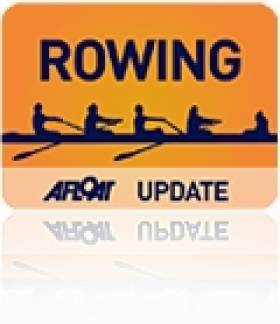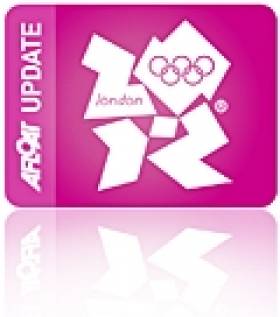Displaying items by tag: medal
McCrohan Wins Bronze Medal at World Cup Rowing Regatta
Irish rowing got a real fillip today when lightweight single sculler Siobhan McCrohan won a bronze medal at the World Cup rowing regatta at Lucerne. In a race won by the outstanding Greek talent Alexandra Tsiavou, the 24-year-old Galway woman saw off challenges from Belgium’s Jo Hammond and Poland’s Weronika Deresz to take bronze. Switzerland’s Pamela Weisshaupt took the silver medal.
World Cup Regatta, Lucerne – Day Two (Irish interest)
Men
Lightweight Double Scull – D Final (places 19 to 24): 1 Hungary 6:36.15, 2 Ireland 6:43.77, 3 Sweden 6:44.75.
Women
Double Scull – Semi-Final (First Three to A Final; rest to B Final): 1 Australia 6:54.22, 2 Ukraine 6:56.73, 3 Poland 6:58.30; 4 Belarus 7:07.73, 5 Romania 7:09.95, 6 Ireland (L Dilleen, S Puspure) 7:15.75
Lightweight Double Scull – C Final (Places 13 to 18): 1 Austria 7:14.01; 5 Ireland (S Dolan, C Lambe) 7:19.47
Lightweight Single Scull – Semi-Final One (First Three to A Final; rest to B Final): 1 Switzerland (P Weisshaupt) 7:56.1, 2 Ireland (S McCrohan) 7:58.65, 3 Belgium (J Hammond) 8:03.22; 4 Japan 8:09.31, 5 Canada 8:09.80, 6 Hong Kong 8:14.50. A FINAL: 1 Greece (A Tsiavou) 7:47.78, 2 Switzerland (P Weisshaupt) 7:51.39, 3 Ireland (S McCrohan) 7:54.86; 4 Belgium (J Hammond) 7:55.17, 5 Poland (W Deresz) 7:59.80, 6 Netherlands (M-A Frenken) 8:02.57.
Annalise Murphy is Miami Medal Prospect
The strong Dun Laoghaire girl relished the prospects of the big winds that blew at times on Biscayne Bay this week. Consistent results of 5, 15, 2, 2, 5, 6 11,9, (21) and 5 never saw her out of the top five.
Tuesday saw her bag two second places in a fleet of 58. It was a turning point in a regatta that she crashed out of last year only to return wth grit to be Ireland's only medal hope today.
Last night's move up to fourth overall on the scoreboard is another confidence boost, heightening the prospect of a place on this evening's podium. Conditions in Miami today are forcast to be light, probably not the conditions the National Yacht club girl would have hoped for.
In the Star Peter O'Leary and his crew for his London 2012 bid David Burrows finished with a strong fifth place yesterday but it was not enough to make today's final. They finished 13th overall after counting a black flag disqualification on day two of the event. See all results HERE.
Rival to Annalise, Tiffany Brien from Belfast Lough finished 21st overall.
Her club mate Jame Espey was 49th out of 52 after 7 races in the Laser gold fleet.
More from Miami organisers below:
Waking to a brisk northwesterly breeze, sailors at US SAILING’s Rolex Miami OCR yesterday made up for races lost to light air Wednesday. The conditions, though chilly by Florida standards, played out perfectly for medals to be determined in three Paralympic classes, while 10 Olympic classes fought their final battles for the right to compete in tomorrow’s medal races, which are comprised of top-ten “sail-offs” for Finn, 49er, Men’s 470, Women’s 470, Laser, Laser Radial, Men’s RS:X, Women’s RS:X and Star classes, and Finals and Petit Finals for Elliott 6m (women’s match racing). The regatta, which began Monday for 716 sailors from 53 nations, prepares Olympic and Paralympic sailing aspirants for the 2012 Games and is the second of seven stops on the International Sailing Federation (ISAF) Sailing World Cup circuit.
For France’s Damien Seguin, a two-time 2.4mR IFDS World Champion who is currently ranked #1 in the world, winning gold in the Paralympic 2.4mR class was looking good from day two when he assumed the lead over his 30-boat fleet. Clinching today, however, was not as straightforward as today’s scores seemed to reflect. Following seven boat lengths behind leader USA’s John Ruf (Pewaukee, Wis.) at the finish in race one, Seguin was determined the actual winner when Ruf was disqualified for starting the race prematurely and neglecting to exonerate himself. “After that, for my next two races, my score was such that I needed only to loosely cover Thierry Schmitter (NED),” said Seguin, further explaining that only if he finished worse than sixth would he foil his own plot. Schmitter, another IFDS World Champion, took the Silver Medal, finishing fourth in the first race and winning the next two, each time with Seguin behind in second.
“There were many different winds here,” said Damien about the practice this provides for his run for a spot on the French national team. “We started in strong wind, then there was light wind and today medium-strong. I am very happy for that and for the competition.”
Taking bronze was Canada’s Allan Leibel, who is able-bodied and allowed to compete here, since the class is declared “open” for this event.
The Gold Medal taking in the Paralympic Sonar class by GBR’s John Robertson/Hannah Stodel/Steve Thomas came with an intriguing twist today. With two races completed, the Dutch team of Udo Hessels/Mischa Rossen/Marcel van de Veen were in the lead, and surprisingly, they did not sail the third and final race.
“There were two points between us and the Dutch, so no one will ever know how it would have played out on the water,” said Robertson, explaining that he understands Hessel’s middle crew Rossen, a single-arm amputee, had been having problems with his opposite shoulder and the team had decided beforehand to race no more than two races today.
Robertson’s team, which took the Silver here last year, posted a final score of 30 to the 36 points posted by silver medalists Bruon Jourdren/Eric Flageul/Nicolas Vimont Vicary (FRA). The Dutch team, with 37 points, is going home with the Bronze.
As for his team’s overall strategy here, Robertson said, “We tried to sail our own race and not get hung up with the other guys. Hanna did a fantastic job calling tactics, especially today, as the wind was up and down and all over the place, with 40-50 degree shifts.”
The Australian Paralympic SKUD 18 team of Daniel Fitzgibbon/Liesl Tesch has led their fleet since day one and boasted six victories in their nine-race score line to take the Gold medal. Today they finished 1-1-2.
“We didn’t walk away with it, really, but we were comfortably ahead,” said Fitzgibbon, who won a Paralympic Silver Medal (with a different crew) in Qingdao. "We didn’t expect to have done so well with such a new combination,” he added, noting that he and Tesch, who gave up Paralympic basketball (she is a two-time medalist) for her new-found love of sailing, have only been together on the SKUD 18 for a few weeks. “It’s a new challenge for her and a breath of fresh air for everybody.”
Taking Silver was US Sailing Team AlphaGraphics’ Scott Whitman/Julia Dorsett (USA), with Alexandra Rickham/Niki Birrell (GBR) taking the Bronze.
Medal Races Tomorrow
Top-ten finishers from today in each of nine Olympic classes will get only one chance--a 30- to 40-minute race—to make or break their claim to a podium position. Emulating the Olympic format, the medal race counts double points and cannot be counted as the one allowed discard race when it is added to a sailor’s score line from the rest of the series.
In women’s match racing, US Sailing Team AlphaGraphics members Anna Tunnicliffe(/Molly Vandemoer/Debbie Capozzi (Plantation, Fla., USA/Redwood City, Calif./Bayport, N.Y., USA) will meet Claire Leroy/ Elodie Bertrand/Marie Riou (FRA) in a first-to-three points Finals match tomorrow to determine Gold and Silver medalists. Lucy Macgregor/Mary Rook/ Kate Macgregor (GBR) and Sally Barkow (Nashotah, WI., USA)/ Alana O’Reilly (Charleston SC, USA)/ Elizabeth Kratzig-Burnham (Miami Beach FL, USA) will be fighting for bronze in the Petit Finals.
Match racing starts on its own course at 9:30 tomorrow, with fleet racing starting at 11:00 am on two additional courses. Fleet races are planned to be approximately 30 minutes in length and started 40 minutes apart. No racing will start after 1:40 p.m., so it will be an early day.
US SAILING has partnered with the city of Miami to provide world-class venues for competition. Additional hosts for the event include Coral Reef Yacht Club, Key Biscayne Yacht Club, Coconut Grove Sailing Club, Miami Rowing Club and Shake-a-Leg Miami. These sailing organizations host classes onshore, as well as help run the on-the-water racing. The Coral Reef Yacht Club also hosts the Opening and Closing Ceremonies.
In addition to title sponsor Rolex Watch U.S.A., US SAILING’s 2011 Rolex Miami OCR is also sponsored by AlphaGraphics, Gowrie Group, Chubb Insurance, Sperry Top-Sider, Harken McLube, Trinity Yachts, University of Miami Hospital and Kattack.
A complete roster of competitors can be viewed at the event website, RMOCR.ussailing.org, where real-time racecourse blogging, commentary and fan interaction, regatta results, photos and news updates will be integrated into a live coverage platform once racing begins. Video highlights produced by Gary Jobson and presented by Rolex air daily and are available on-demand on the event website. Fans can also follow the event on Facebook/RolexMiamiOCR and Twitter/RolexMiamiOCR.
More in our Olympics 2012 category HERE
Bangor Helmsmen Awarded Medals for Twenty Years Service
Recently two well known and respected volunteer Bangor Lifeboat helmsmen were awarded medals in recognition for their many years of devoted service to the Royal National Lifeboat Institution.
Ewan Scott and Tommy Burns have been awarded Long Service medals at recent RNLI ceremonies. During their 20 years of dedicated service, RNLI Bangor Lifeboat has undertaken a total of 845 rescues at sea resulting in the saving of 98 lives.
Both Ewan and Tommy are of one mind and agree that over the years there have been many improvements to the lifeboats, the equipment and training all of which has greatly enhanced the RNLI's ability to save life at sea.
Even after over 20 years of service Ewan and Tommy continue to freely give of their time and effort. They are considered by all to be the most experienced helmsmen at Bangor station and are actively involved in the training of crew and other volunteers.
Bangor's Lifeboat Operations Manager Kevin Byers paid tribute to Ewan and Tommy when he said 'Without the huge commitment and dedication of volunteers like Ewan and Tommy, the RNLI would be unable to carry out the increasingly demanding task of saving lives at sea.' Kevin went on to say 'I am delighted that Ewan and Tommy have been presented with these awards, they deserve a big thank you for all they have done for Bangor Lifeboat over the past 20 years.'

Related Safety posts
RNLI Lifeboats in Ireland
Safety News
Rescue News from RNLI Lifeboats in Ireland
Coast Guard News from Ireland
Water Safety News from Ireland
Marine Casualty Investigation Board News
Marine Warnings































































